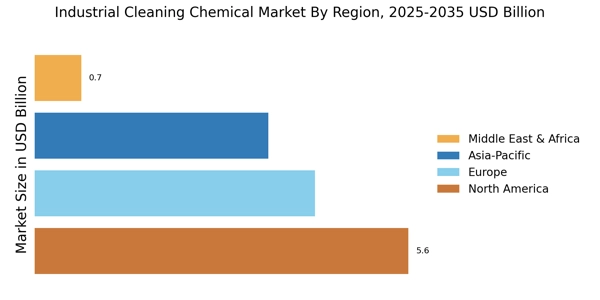Stringent Regulatory Frameworks
The implementation of stringent regulatory frameworks is a crucial driver for the Industrial Cleaning Chemical Market. Governments and regulatory bodies are increasingly enforcing regulations that mandate the use of safe and effective cleaning agents in various industries. Compliance with these regulations is essential for companies to avoid penalties and maintain their operational licenses. As a result, there is a growing demand for cleaning chemicals that meet regulatory standards while ensuring safety for both workers and the environment. This trend is likely to continue, as regulatory scrutiny intensifies, pushing companies to invest in compliant cleaning solutions that align with evolving safety and environmental standards.
Rising Demand for Hygiene Solutions
The increasing emphasis on hygiene across various sectors is a primary driver for the Industrial Cleaning Chemical Market. Industries such as food processing, healthcare, and hospitality are prioritizing cleanliness to ensure safety and compliance with health regulations. This heightened focus on hygiene has led to a surge in demand for effective cleaning solutions. According to recent data, the industrial cleaning chemicals segment is projected to grow at a compound annual growth rate of approximately 5.5% over the next few years. This growth is indicative of the market's response to the rising need for sanitation and cleanliness, which is likely to persist as industries adapt to evolving consumer expectations.
Expansion of Manufacturing Activities
The ongoing expansion of manufacturing activities across various sectors is significantly influencing the Industrial Cleaning Chemical Market. As production facilities scale up operations, the need for efficient cleaning solutions becomes paramount to maintain operational efficiency and safety standards. The manufacturing sector, particularly in automotive, electronics, and pharmaceuticals, is witnessing robust growth, which in turn drives the demand for industrial cleaning chemicals. Recent statistics indicate that the manufacturing sector's contribution to the economy is expected to increase, thereby propelling the need for specialized cleaning agents that can effectively address the unique challenges posed by different manufacturing processes.
Technological Advancements in Cleaning Solutions
Technological advancements are reshaping the Industrial Cleaning Chemical Market by introducing innovative cleaning solutions that enhance efficiency and effectiveness. The development of eco-friendly and biodegradable cleaning agents is gaining traction, as industries seek to minimize their environmental impact. Furthermore, advancements in formulation technologies are leading to the creation of specialized cleaning products that cater to specific industrial needs. For instance, the introduction of nanotechnology in cleaning agents is expected to improve cleaning performance significantly. This trend is likely to attract investments in research and development, fostering a competitive landscape that encourages the emergence of new and improved cleaning solutions.
Growth of E-commerce and Online Distribution Channels
The growth of e-commerce and online distribution channels is transforming the Industrial Cleaning Chemical Market by providing easier access to a wide range of cleaning products. As businesses increasingly turn to online platforms for procurement, suppliers are adapting their strategies to meet this demand. This shift not only enhances convenience for buyers but also expands market reach for manufacturers. Recent data suggests that online sales of industrial cleaning chemicals are expected to rise significantly, driven by the increasing preference for digital purchasing. This trend is likely to reshape the competitive landscape, as companies that effectively leverage online channels may gain a competitive edge in the market.


















Leave a Comment